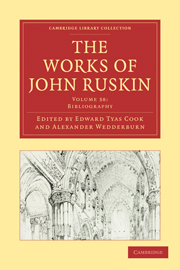Book contents
- Frontmatter
- Contents
- LIST OF ILLUSTRATIONS
- INTRODUCTION TO THIS VOLUME
- PART I BIBLIOGRAPHY
- PART II CATALOGUE OF RUSKIN'S DRAWINGS (with Index References)
- PART III ADDENDA ET CORRIGENDA
- I BIBLIOGRAPHICAL, 1903–1911 (Supplementary to the Detailed Notes in earlier volumes)
- II ADDITIONAL MATTER
- III CORRECTIONS IN THE TEXT AND NOTES, AND ADDITIONS, VOLS. I.-XXXVII
- IV TURNER DRAWINGS AT THE NATIONAL GALLERY AND TATE GALLERY: REVISED NUMBERS
- Plate section
II - ADDITIONAL MATTER
Published online by Cambridge University Press: 07 September 2011
- Frontmatter
- Contents
- LIST OF ILLUSTRATIONS
- INTRODUCTION TO THIS VOLUME
- PART I BIBLIOGRAPHY
- PART II CATALOGUE OF RUSKIN'S DRAWINGS (with Index References)
- PART III ADDENDA ET CORRIGENDA
- I BIBLIOGRAPHICAL, 1903–1911 (Supplementary to the Detailed Notes in earlier volumes)
- II ADDITIONAL MATTER
- III CORRECTIONS IN THE TEXT AND NOTES, AND ADDITIONS, VOLS. I.-XXXVII
- IV TURNER DRAWINGS AT THE NATIONAL GALLERY AND TATE GALLERY: REVISED NUMBERS
- Plate section
Summary
[Bibliographical Note.–The Notes here collected have hitherto escaped the attention of Ruskin's editors and bibliographers. They are taken (with revision and curtailment) from a note-book, preserved at Brantwood, which Ruskin filled during his Italian journey in 1845, and which has often been quoted from in this edition (see above, p. 85). At p. x. of the Handbook it is explained that “The observations between inverted commas to which the letter R. is appended, are by the author of Modern Painters.”
The Notes were repeated in the fourth (1852), fifth (1854), and sixth (1856) editions. They then gradually disappeared—some for a while surviving intact, others having the inverted commas removed and being paraphrased.]
On the church of St. Andrea at Carrara (p. 406):–
“It corresponds in age and style with the Duomo of Monza. These two buildings afford examples of a peculiar and most graceful Gothic. Fragments of a similar style occur at Sarzana; but this church at Carrara is decidedly the most perfect gem of its kind. I prefer it to that at Monza.”
On the churches of S. Martino and S. Michele at Lucca (p. 409):–
“The rich inlaid work of the fronts of this church and S. Michele are altogether unique. Both represent hunting-pieces, lions, wild boars, wolves, foxes, and deer pursued by hounds and men, with lance and horn, constantly repeated.”
- Type
- Chapter
- Information
- The Works of John Ruskin , pp. 326 - 349Publisher: Cambridge University PressPrint publication year: 2010First published in: 1912

